Mid-Semester Examination ICT220 Wireless Communications, USC, 2020
VerifiedAdded on 2022/09/11
|8
|1614
|15
Homework Assignment
AI Summary
This document presents a comprehensive solution to the ICT220 Wireless Communications mid-semester examination from the University of Southern California (USC), Semester 1, 2020. The exam covers various aspects of wireless communication technologies. The solution includes detailed answers to short answer questions, exploring technologies like satellite communication, IR wireless communication, and broadcast radio. It also compares and contrasts IEEE 802.11b and 802.11ax WiFi standards, analyzes a 5 GHz WiFi receiver, and addresses questions related to RF signals, including frequency, amplitude, wavelength, phase difference, and time delay calculations. The document provides a valuable resource for students studying wireless communications, offering insights into key concepts and practical applications. The solution is contributed by a student to Desklib, a platform providing AI-based study tools for students.
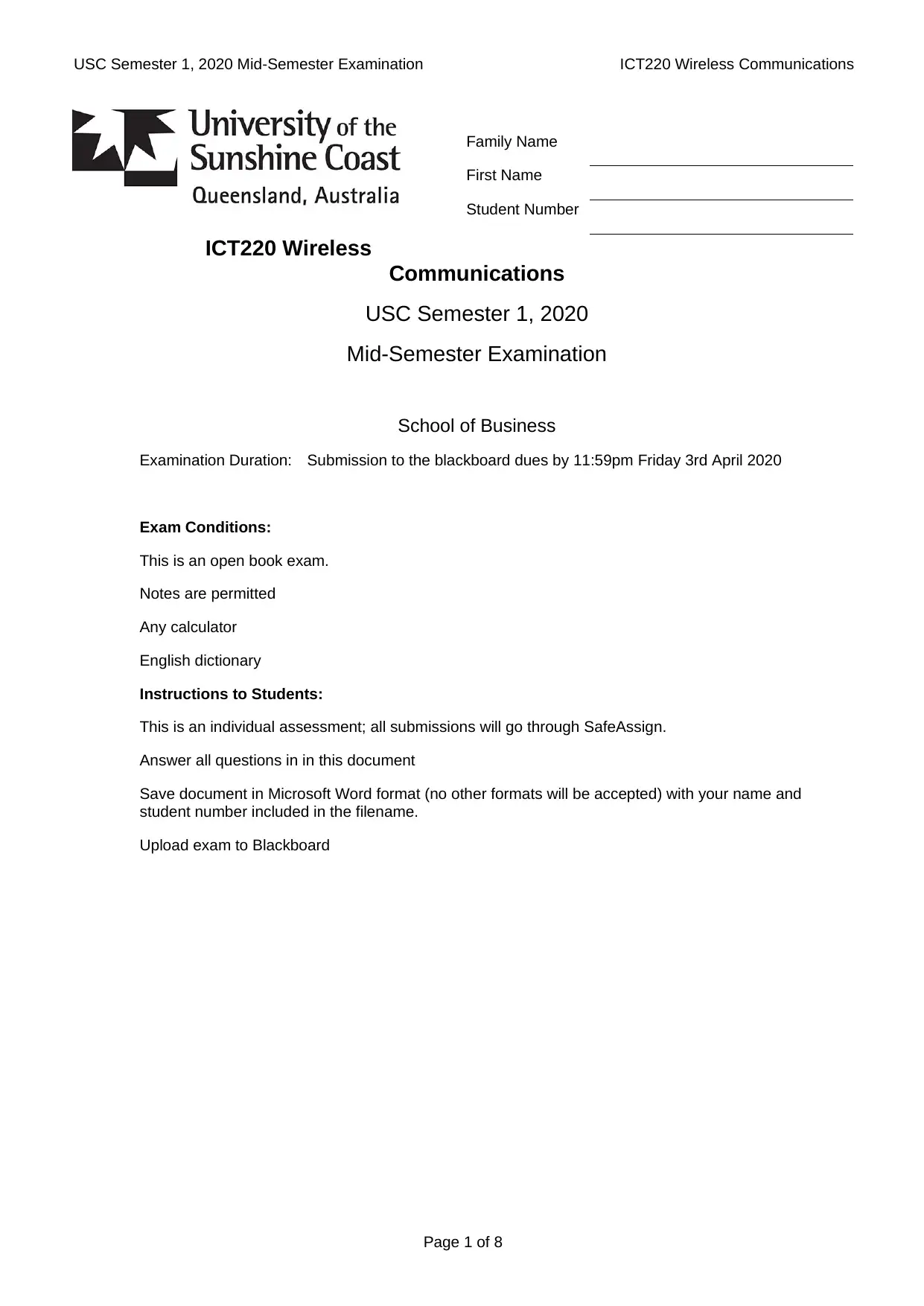
USC Semester 1, 2020 Mid-Semester Examination ICT220 Wireless Communications
ICT220 Wireless
Communications
USC Semester 1, 2020
Mid-Semester Examination
School of Business
Examination Duration: Submission to the blackboard dues by 11:59pm Friday 3rd April 2020
Exam Conditions:
This is an open book exam.
Notes are permitted
Any calculator
English dictionary
Instructions to Students:
This is an individual assessment; all submissions will go through SafeAssign.
Answer all questions in in this document
Save document in Microsoft Word format (no other formats will be accepted) with your name and
student number included in the filename.
Upload exam to Blackboard
Page 1 of 8
Family Name
First Name
Student Number
ICT220 Wireless
Communications
USC Semester 1, 2020
Mid-Semester Examination
School of Business
Examination Duration: Submission to the blackboard dues by 11:59pm Friday 3rd April 2020
Exam Conditions:
This is an open book exam.
Notes are permitted
Any calculator
English dictionary
Instructions to Students:
This is an individual assessment; all submissions will go through SafeAssign.
Answer all questions in in this document
Save document in Microsoft Word format (no other formats will be accepted) with your name and
student number included in the filename.
Upload exam to Blackboard
Page 1 of 8
Family Name
First Name
Student Number
Paraphrase This Document
Need a fresh take? Get an instant paraphrase of this document with our AI Paraphraser
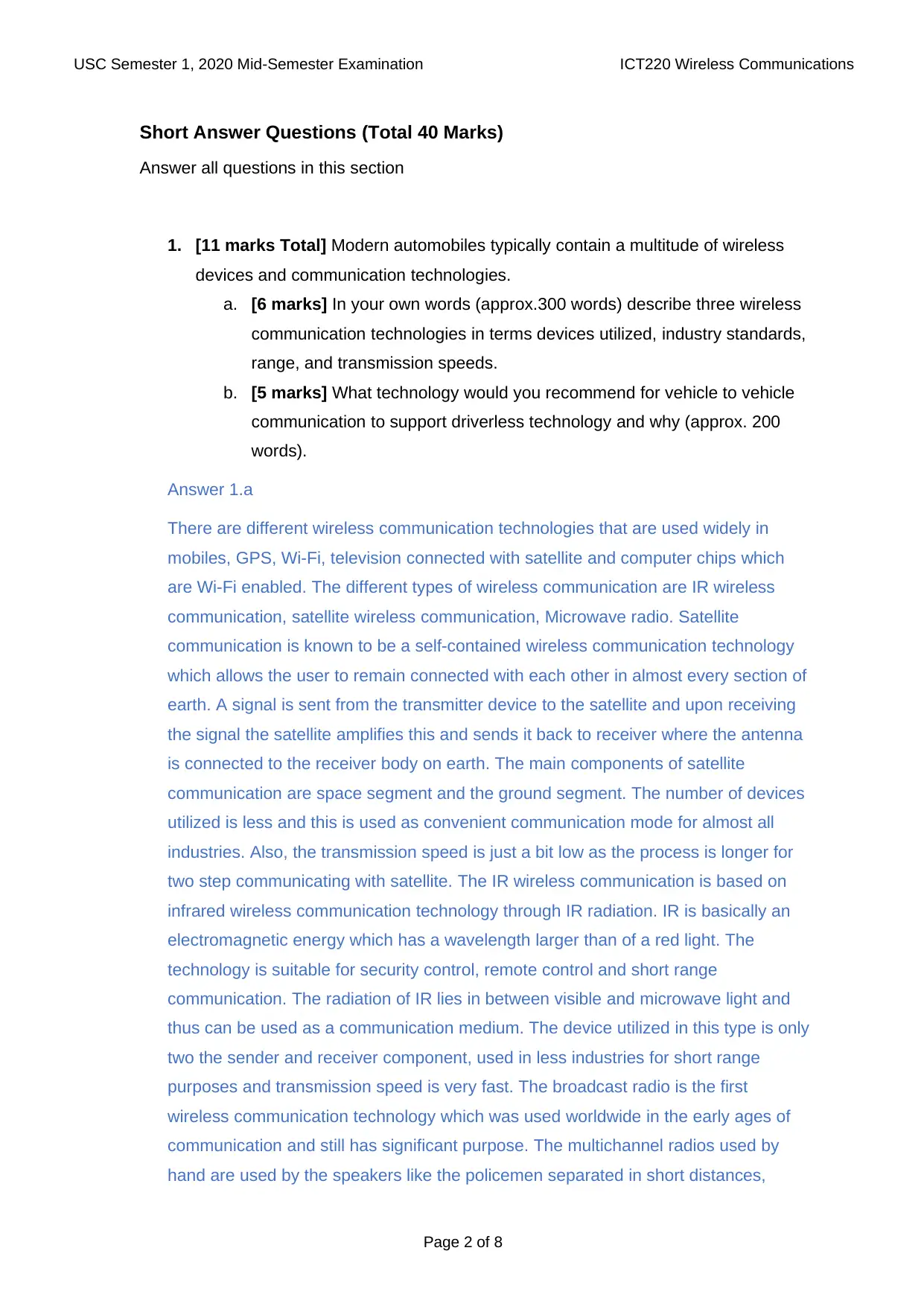
USC Semester 1, 2020 Mid-Semester Examination ICT220 Wireless Communications
Short Answer Questions (Total 40 Marks)
Answer all questions in this section
1. [11 marks Total] Modern automobiles typically contain a multitude of wireless
devices and communication technologies.
a. [6 marks] In your own words (approx.300 words) describe three wireless
communication technologies in terms devices utilized, industry standards,
range, and transmission speeds.
b. [5 marks] What technology would you recommend for vehicle to vehicle
communication to support driverless technology and why (approx. 200
words).
Answer 1.a
There are different wireless communication technologies that are used widely in
mobiles, GPS, Wi-Fi, television connected with satellite and computer chips which
are Wi-Fi enabled. The different types of wireless communication are IR wireless
communication, satellite wireless communication, Microwave radio. Satellite
communication is known to be a self-contained wireless communication technology
which allows the user to remain connected with each other in almost every section of
earth. A signal is sent from the transmitter device to the satellite and upon receiving
the signal the satellite amplifies this and sends it back to receiver where the antenna
is connected to the receiver body on earth. The main components of satellite
communication are space segment and the ground segment. The number of devices
utilized is less and this is used as convenient communication mode for almost all
industries. Also, the transmission speed is just a bit low as the process is longer for
two step communicating with satellite. The IR wireless communication is based on
infrared wireless communication technology through IR radiation. IR is basically an
electromagnetic energy which has a wavelength larger than of a red light. The
technology is suitable for security control, remote control and short range
communication. The radiation of IR lies in between visible and microwave light and
thus can be used as a communication medium. The device utilized in this type is only
two the sender and receiver component, used in less industries for short range
purposes and transmission speed is very fast. The broadcast radio is the first
wireless communication technology which was used worldwide in the early ages of
communication and still has significant purpose. The multichannel radios used by
hand are used by the speakers like the policemen separated in short distances,
Page 2 of 8
Short Answer Questions (Total 40 Marks)
Answer all questions in this section
1. [11 marks Total] Modern automobiles typically contain a multitude of wireless
devices and communication technologies.
a. [6 marks] In your own words (approx.300 words) describe three wireless
communication technologies in terms devices utilized, industry standards,
range, and transmission speeds.
b. [5 marks] What technology would you recommend for vehicle to vehicle
communication to support driverless technology and why (approx. 200
words).
Answer 1.a
There are different wireless communication technologies that are used widely in
mobiles, GPS, Wi-Fi, television connected with satellite and computer chips which
are Wi-Fi enabled. The different types of wireless communication are IR wireless
communication, satellite wireless communication, Microwave radio. Satellite
communication is known to be a self-contained wireless communication technology
which allows the user to remain connected with each other in almost every section of
earth. A signal is sent from the transmitter device to the satellite and upon receiving
the signal the satellite amplifies this and sends it back to receiver where the antenna
is connected to the receiver body on earth. The main components of satellite
communication are space segment and the ground segment. The number of devices
utilized is less and this is used as convenient communication mode for almost all
industries. Also, the transmission speed is just a bit low as the process is longer for
two step communicating with satellite. The IR wireless communication is based on
infrared wireless communication technology through IR radiation. IR is basically an
electromagnetic energy which has a wavelength larger than of a red light. The
technology is suitable for security control, remote control and short range
communication. The radiation of IR lies in between visible and microwave light and
thus can be used as a communication medium. The device utilized in this type is only
two the sender and receiver component, used in less industries for short range
purposes and transmission speed is very fast. The broadcast radio is the first
wireless communication technology which was used worldwide in the early ages of
communication and still has significant purpose. The multichannel radios used by
hand are used by the speakers like the policemen separated in short distances,
Page 2 of 8
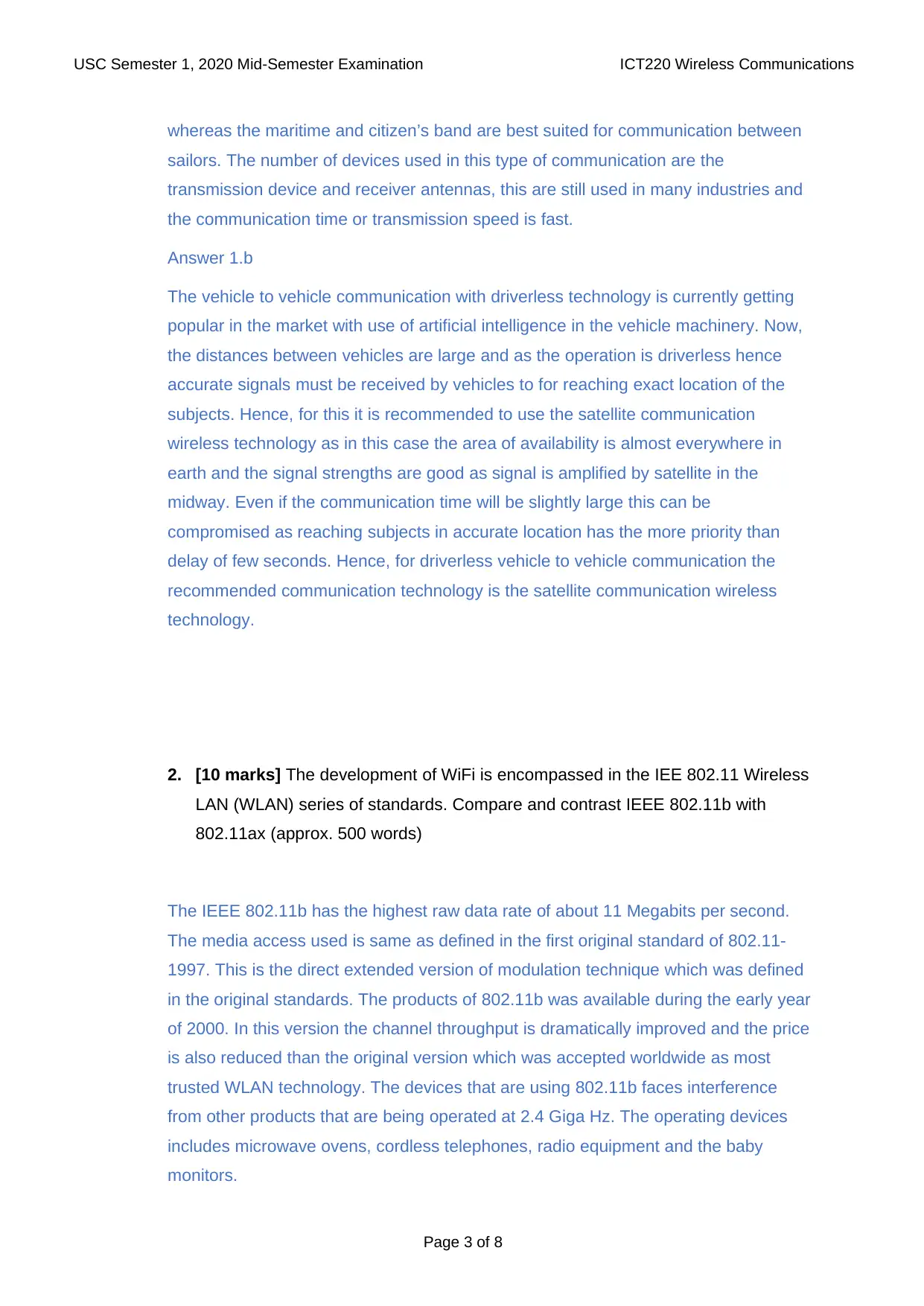
USC Semester 1, 2020 Mid-Semester Examination ICT220 Wireless Communications
whereas the maritime and citizen’s band are best suited for communication between
sailors. The number of devices used in this type of communication are the
transmission device and receiver antennas, this are still used in many industries and
the communication time or transmission speed is fast.
Answer 1.b
The vehicle to vehicle communication with driverless technology is currently getting
popular in the market with use of artificial intelligence in the vehicle machinery. Now,
the distances between vehicles are large and as the operation is driverless hence
accurate signals must be received by vehicles to for reaching exact location of the
subjects. Hence, for this it is recommended to use the satellite communication
wireless technology as in this case the area of availability is almost everywhere in
earth and the signal strengths are good as signal is amplified by satellite in the
midway. Even if the communication time will be slightly large this can be
compromised as reaching subjects in accurate location has the more priority than
delay of few seconds. Hence, for driverless vehicle to vehicle communication the
recommended communication technology is the satellite communication wireless
technology.
2. [10 marks] The development of WiFi is encompassed in the IEE 802.11 Wireless
LAN (WLAN) series of standards. Compare and contrast IEEE 802.11b with
802.11ax (approx. 500 words)
The IEEE 802.11b has the highest raw data rate of about 11 Megabits per second.
The media access used is same as defined in the first original standard of 802.11-
1997. This is the direct extended version of modulation technique which was defined
in the original standards. The products of 802.11b was available during the early year
of 2000. In this version the channel throughput is dramatically improved and the price
is also reduced than the original version which was accepted worldwide as most
trusted WLAN technology. The devices that are using 802.11b faces interference
from other products that are being operated at 2.4 Giga Hz. The operating devices
includes microwave ovens, cordless telephones, radio equipment and the baby
monitors.
Page 3 of 8
whereas the maritime and citizen’s band are best suited for communication between
sailors. The number of devices used in this type of communication are the
transmission device and receiver antennas, this are still used in many industries and
the communication time or transmission speed is fast.
Answer 1.b
The vehicle to vehicle communication with driverless technology is currently getting
popular in the market with use of artificial intelligence in the vehicle machinery. Now,
the distances between vehicles are large and as the operation is driverless hence
accurate signals must be received by vehicles to for reaching exact location of the
subjects. Hence, for this it is recommended to use the satellite communication
wireless technology as in this case the area of availability is almost everywhere in
earth and the signal strengths are good as signal is amplified by satellite in the
midway. Even if the communication time will be slightly large this can be
compromised as reaching subjects in accurate location has the more priority than
delay of few seconds. Hence, for driverless vehicle to vehicle communication the
recommended communication technology is the satellite communication wireless
technology.
2. [10 marks] The development of WiFi is encompassed in the IEE 802.11 Wireless
LAN (WLAN) series of standards. Compare and contrast IEEE 802.11b with
802.11ax (approx. 500 words)
The IEEE 802.11b has the highest raw data rate of about 11 Megabits per second.
The media access used is same as defined in the first original standard of 802.11-
1997. This is the direct extended version of modulation technique which was defined
in the original standards. The products of 802.11b was available during the early year
of 2000. In this version the channel throughput is dramatically improved and the price
is also reduced than the original version which was accepted worldwide as most
trusted WLAN technology. The devices that are using 802.11b faces interference
from other products that are being operated at 2.4 Giga Hz. The operating devices
includes microwave ovens, cordless telephones, radio equipment and the baby
monitors.
Page 3 of 8
⊘ This is a preview!⊘
Do you want full access?
Subscribe today to unlock all pages.

Trusted by 1+ million students worldwide
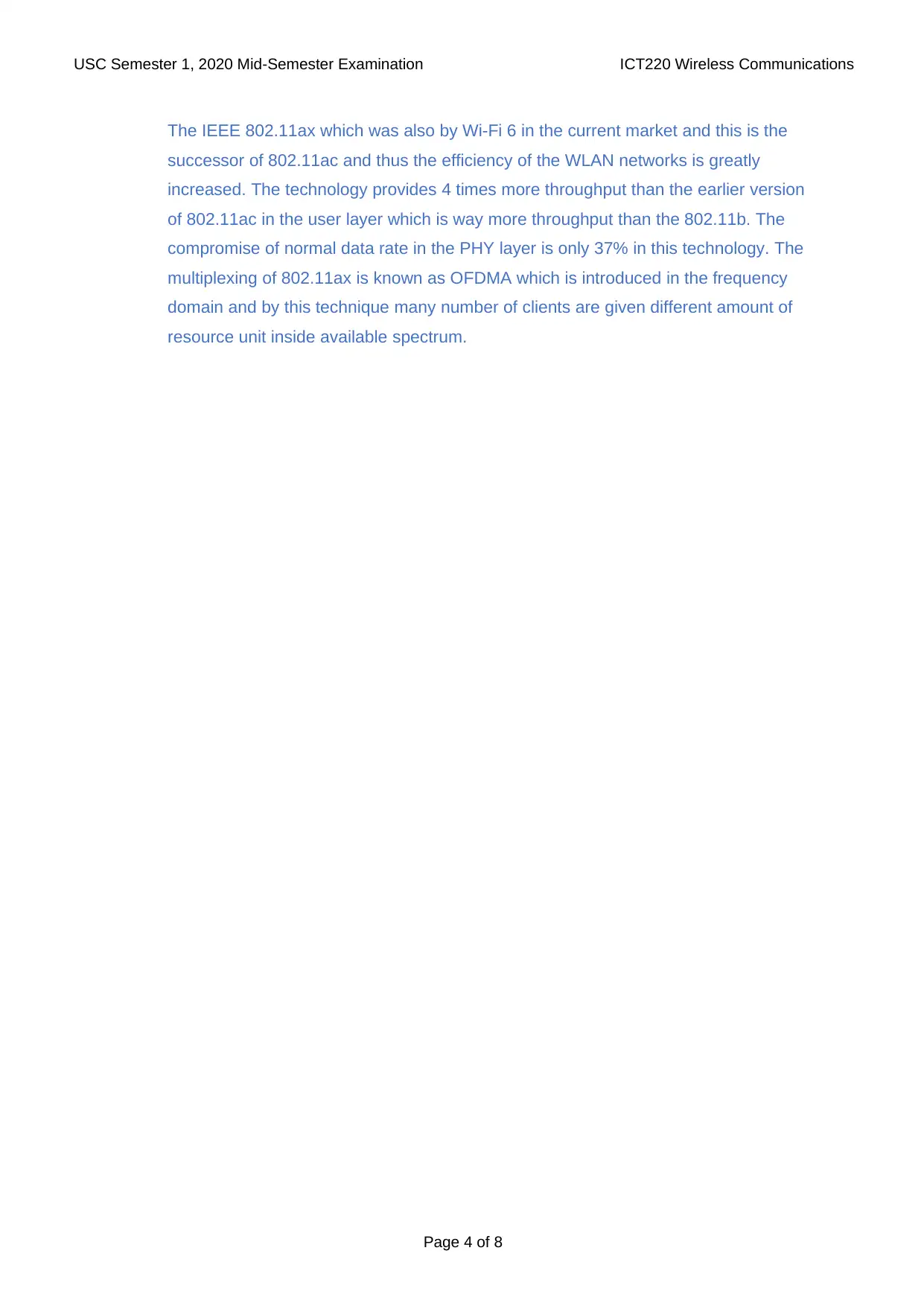
USC Semester 1, 2020 Mid-Semester Examination ICT220 Wireless Communications
The IEEE 802.11ax which was also by Wi-Fi 6 in the current market and this is the
successor of 802.11ac and thus the efficiency of the WLAN networks is greatly
increased. The technology provides 4 times more throughput than the earlier version
of 802.11ac in the user layer which is way more throughput than the 802.11b. The
compromise of normal data rate in the PHY layer is only 37% in this technology. The
multiplexing of 802.11ax is known as OFDMA which is introduced in the frequency
domain and by this technique many number of clients are given different amount of
resource unit inside available spectrum.
Page 4 of 8
The IEEE 802.11ax which was also by Wi-Fi 6 in the current market and this is the
successor of 802.11ac and thus the efficiency of the WLAN networks is greatly
increased. The technology provides 4 times more throughput than the earlier version
of 802.11ac in the user layer which is way more throughput than the 802.11b. The
compromise of normal data rate in the PHY layer is only 37% in this technology. The
multiplexing of 802.11ax is known as OFDMA which is introduced in the frequency
domain and by this technique many number of clients are given different amount of
resource unit inside available spectrum.
Page 4 of 8
Paraphrase This Document
Need a fresh take? Get an instant paraphrase of this document with our AI Paraphraser
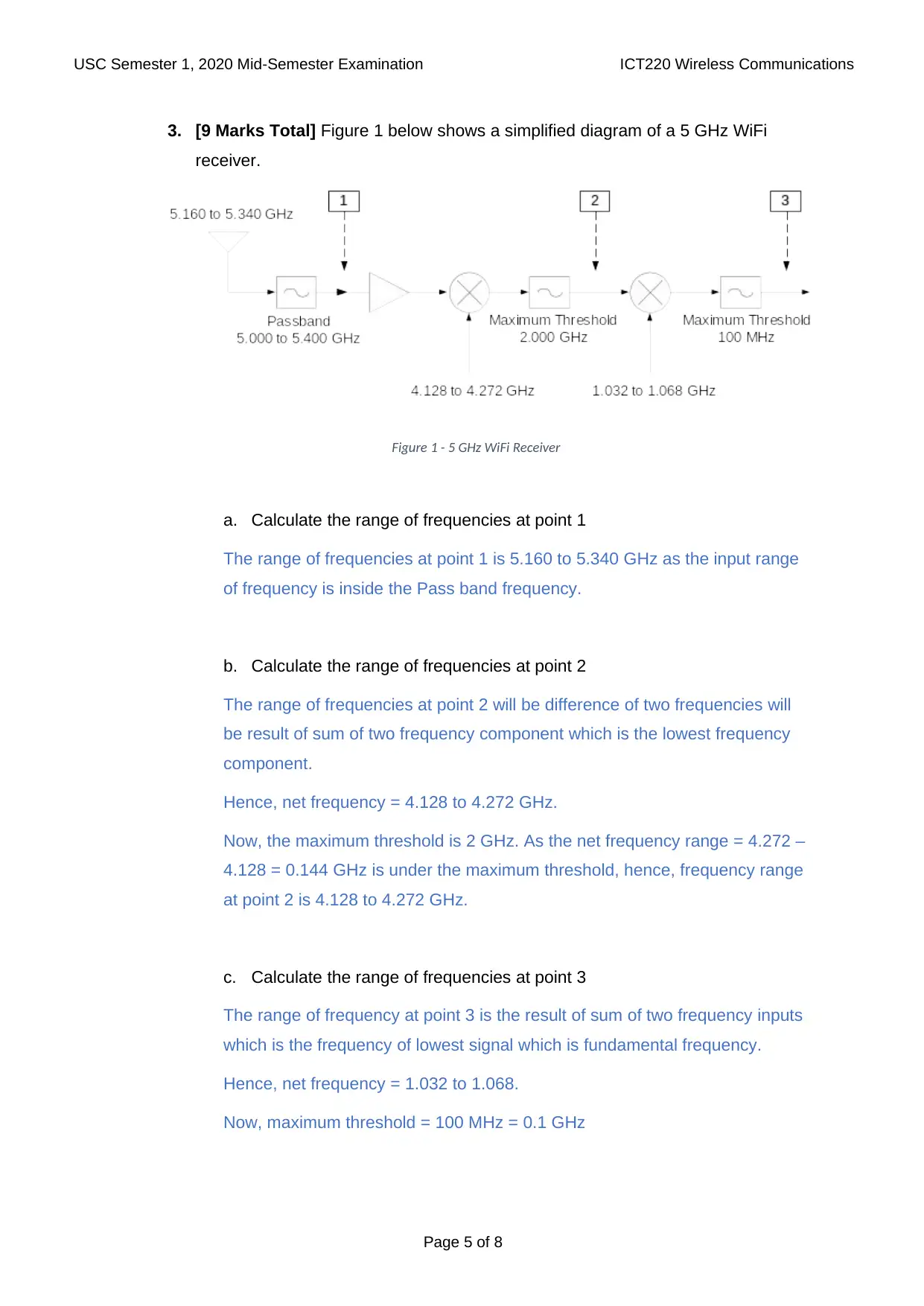
USC Semester 1, 2020 Mid-Semester Examination ICT220 Wireless Communications
3. [9 Marks Total] Figure 1 below shows a simplified diagram of a 5 GHz WiFi
receiver.
Figure 1 - 5 GHz WiFi Receiver
a. Calculate the range of frequencies at point 1
The range of frequencies at point 1 is 5.160 to 5.340 GHz as the input range
of frequency is inside the Pass band frequency.
b. Calculate the range of frequencies at point 2
The range of frequencies at point 2 will be difference of two frequencies will
be result of sum of two frequency component which is the lowest frequency
component.
Hence, net frequency = 4.128 to 4.272 GHz.
Now, the maximum threshold is 2 GHz. As the net frequency range = 4.272 –
4.128 = 0.144 GHz is under the maximum threshold, hence, frequency range
at point 2 is 4.128 to 4.272 GHz.
c. Calculate the range of frequencies at point 3
The range of frequency at point 3 is the result of sum of two frequency inputs
which is the frequency of lowest signal which is fundamental frequency.
Hence, net frequency = 1.032 to 1.068.
Now, maximum threshold = 100 MHz = 0.1 GHz
Page 5 of 8
3. [9 Marks Total] Figure 1 below shows a simplified diagram of a 5 GHz WiFi
receiver.
Figure 1 - 5 GHz WiFi Receiver
a. Calculate the range of frequencies at point 1
The range of frequencies at point 1 is 5.160 to 5.340 GHz as the input range
of frequency is inside the Pass band frequency.
b. Calculate the range of frequencies at point 2
The range of frequencies at point 2 will be difference of two frequencies will
be result of sum of two frequency component which is the lowest frequency
component.
Hence, net frequency = 4.128 to 4.272 GHz.
Now, the maximum threshold is 2 GHz. As the net frequency range = 4.272 –
4.128 = 0.144 GHz is under the maximum threshold, hence, frequency range
at point 2 is 4.128 to 4.272 GHz.
c. Calculate the range of frequencies at point 3
The range of frequency at point 3 is the result of sum of two frequency inputs
which is the frequency of lowest signal which is fundamental frequency.
Hence, net frequency = 1.032 to 1.068.
Now, maximum threshold = 100 MHz = 0.1 GHz
Page 5 of 8

USC Semester 1, 2020 Mid-Semester Examination ICT220 Wireless Communications
Hence, as the range of frequency = 1.068-1.032 = 0.036 Hz is under the
threshold hence the range of frequencies at point 3 is 1.032 to 1.068 GHz.
Page 6 of 8
Hence, as the range of frequency = 1.068-1.032 = 0.036 Hz is under the
threshold hence the range of frequencies at point 3 is 1.032 to 1.068 GHz.
Page 6 of 8
⊘ This is a preview!⊘
Do you want full access?
Subscribe today to unlock all pages.

Trusted by 1+ million students worldwide
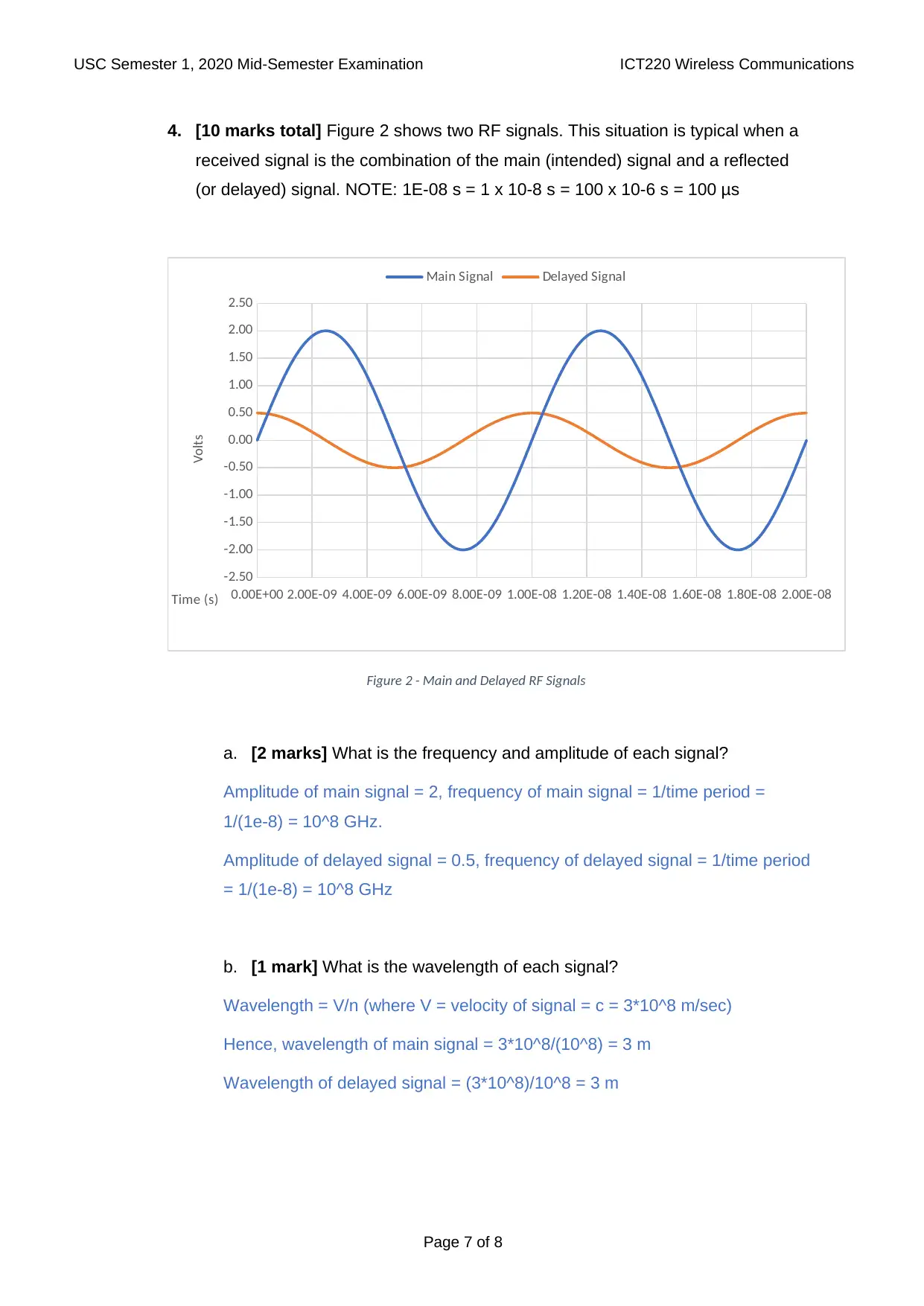
USC Semester 1, 2020 Mid-Semester Examination ICT220 Wireless Communications
4. [10 marks total] Figure 2 shows two RF signals. This situation is typical when a
received signal is the combination of the main (intended) signal and a reflected
(or delayed) signal. NOTE: 1E-08 s = 1 x 10-8 s = 100 x 10-6 s = 100 μs
0.00E+00 2.00E-09 4.00E-09 6.00E-09 8.00E-09 1.00E-08 1.20E-08 1.40E-08 1.60E-08 1.80E-08 2.00E-08
-2.50
-2.00
-1.50
-1.00
-0.50
0.00
0.50
1.00
1.50
2.00
2.50
Main Signal Delayed Signal
Time (s)
Volts
Figure 2 - Main and Delayed RF Signals
a. [2 marks] What is the frequency and amplitude of each signal?
Amplitude of main signal = 2, frequency of main signal = 1/time period =
1/(1e-8) = 10^8 GHz.
Amplitude of delayed signal = 0.5, frequency of delayed signal = 1/time period
= 1/(1e-8) = 10^8 GHz
b. [1 mark] What is the wavelength of each signal?
Wavelength = V/n (where V = velocity of signal = c = 3*10^8 m/sec)
Hence, wavelength of main signal = 3*10^8/(10^8) = 3 m
Wavelength of delayed signal = (3*10^8)/10^8 = 3 m
Page 7 of 8
4. [10 marks total] Figure 2 shows two RF signals. This situation is typical when a
received signal is the combination of the main (intended) signal and a reflected
(or delayed) signal. NOTE: 1E-08 s = 1 x 10-8 s = 100 x 10-6 s = 100 μs
0.00E+00 2.00E-09 4.00E-09 6.00E-09 8.00E-09 1.00E-08 1.20E-08 1.40E-08 1.60E-08 1.80E-08 2.00E-08
-2.50
-2.00
-1.50
-1.00
-0.50
0.00
0.50
1.00
1.50
2.00
2.50
Main Signal Delayed Signal
Time (s)
Volts
Figure 2 - Main and Delayed RF Signals
a. [2 marks] What is the frequency and amplitude of each signal?
Amplitude of main signal = 2, frequency of main signal = 1/time period =
1/(1e-8) = 10^8 GHz.
Amplitude of delayed signal = 0.5, frequency of delayed signal = 1/time period
= 1/(1e-8) = 10^8 GHz
b. [1 mark] What is the wavelength of each signal?
Wavelength = V/n (where V = velocity of signal = c = 3*10^8 m/sec)
Hence, wavelength of main signal = 3*10^8/(10^8) = 3 m
Wavelength of delayed signal = (3*10^8)/10^8 = 3 m
Page 7 of 8
Paraphrase This Document
Need a fresh take? Get an instant paraphrase of this document with our AI Paraphraser
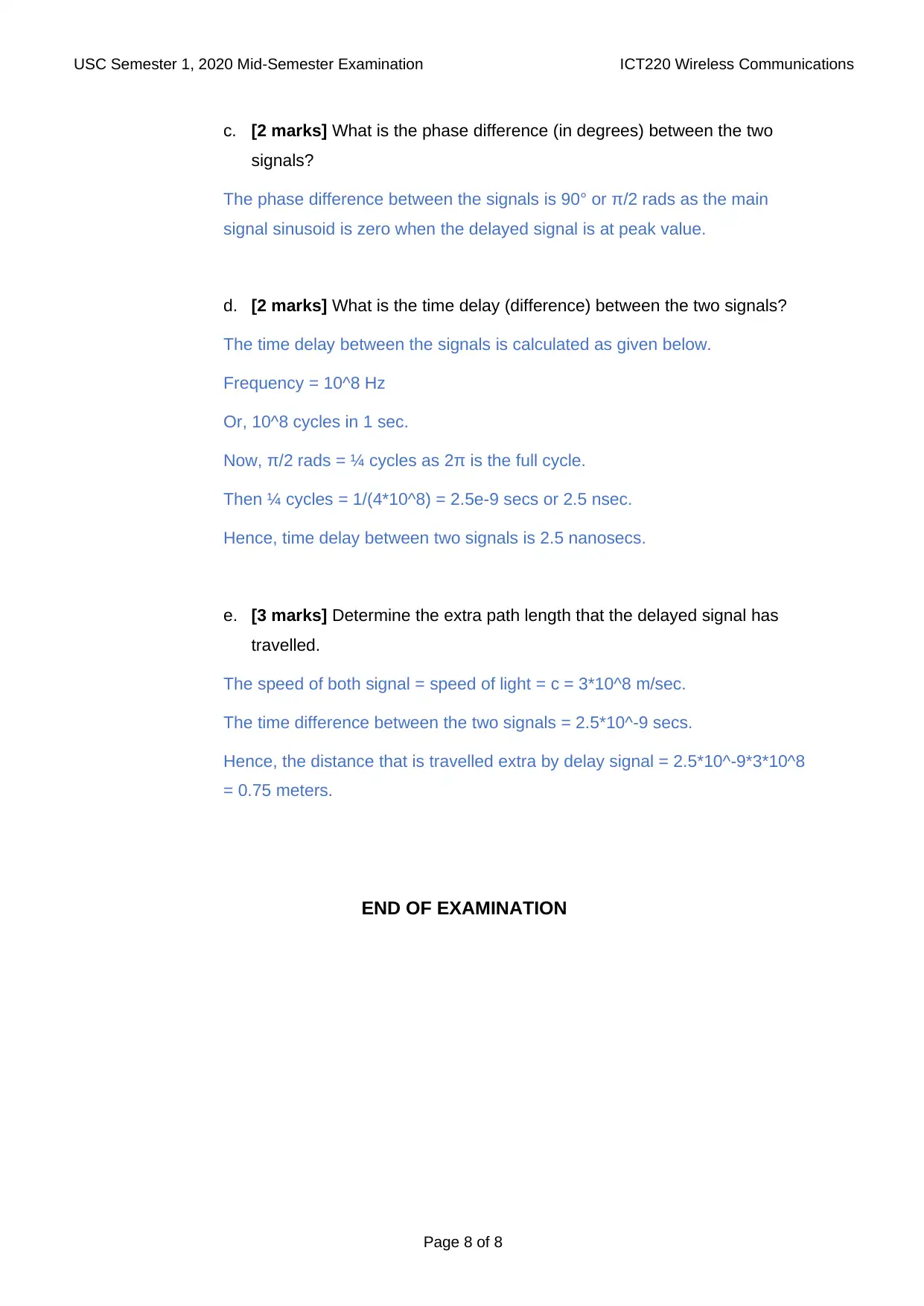
USC Semester 1, 2020 Mid-Semester Examination ICT220 Wireless Communications
c. [2 marks] What is the phase difference (in degrees) between the two
signals?
The phase difference between the signals is 90° or π/2 rads as the main
signal sinusoid is zero when the delayed signal is at peak value.
d. [2 marks] What is the time delay (difference) between the two signals?
The time delay between the signals is calculated as given below.
Frequency = 10^8 Hz
Or, 10^8 cycles in 1 sec.
Now, π/2 rads = ¼ cycles as 2π is the full cycle.
Then ¼ cycles = 1/(4*10^8) = 2.5e-9 secs or 2.5 nsec.
Hence, time delay between two signals is 2.5 nanosecs.
e. [3 marks] Determine the extra path length that the delayed signal has
travelled.
The speed of both signal = speed of light = c = 3*10^8 m/sec.
The time difference between the two signals = 2.5*10^-9 secs.
Hence, the distance that is travelled extra by delay signal = 2.5*10^-9*3*10^8
= 0.75 meters.
END OF EXAMINATION
Page 8 of 8
c. [2 marks] What is the phase difference (in degrees) between the two
signals?
The phase difference between the signals is 90° or π/2 rads as the main
signal sinusoid is zero when the delayed signal is at peak value.
d. [2 marks] What is the time delay (difference) between the two signals?
The time delay between the signals is calculated as given below.
Frequency = 10^8 Hz
Or, 10^8 cycles in 1 sec.
Now, π/2 rads = ¼ cycles as 2π is the full cycle.
Then ¼ cycles = 1/(4*10^8) = 2.5e-9 secs or 2.5 nsec.
Hence, time delay between two signals is 2.5 nanosecs.
e. [3 marks] Determine the extra path length that the delayed signal has
travelled.
The speed of both signal = speed of light = c = 3*10^8 m/sec.
The time difference between the two signals = 2.5*10^-9 secs.
Hence, the distance that is travelled extra by delay signal = 2.5*10^-9*3*10^8
= 0.75 meters.
END OF EXAMINATION
Page 8 of 8
1 out of 8
Related Documents
Your All-in-One AI-Powered Toolkit for Academic Success.
+13062052269
info@desklib.com
Available 24*7 on WhatsApp / Email
![[object Object]](/_next/static/media/star-bottom.7253800d.svg)
Unlock your academic potential
Copyright © 2020–2025 A2Z Services. All Rights Reserved. Developed and managed by ZUCOL.




